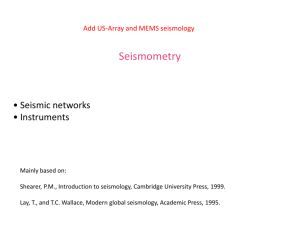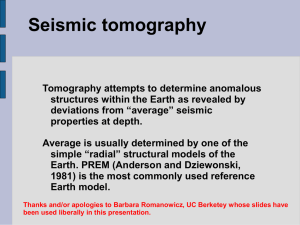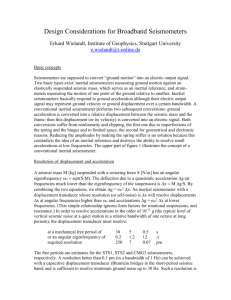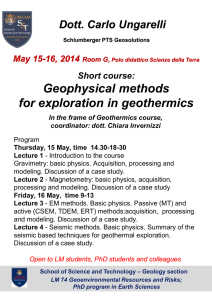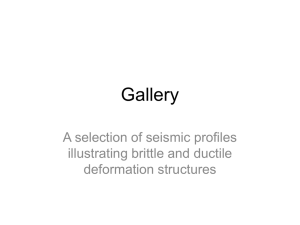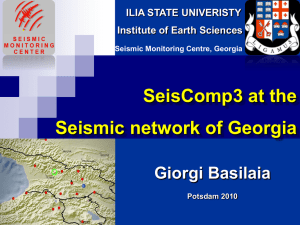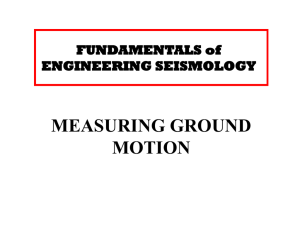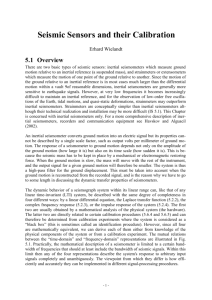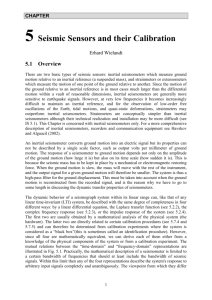ppt
advertisement
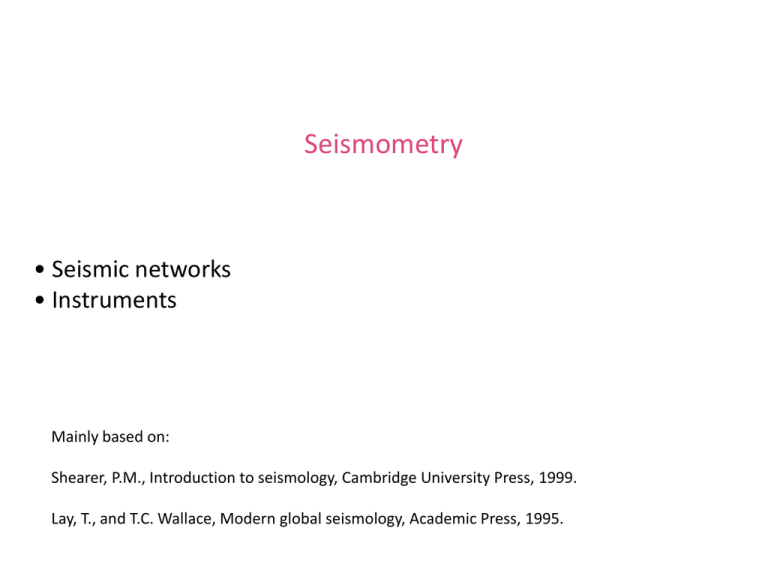
Seismometry • Seismic networks • Instruments Mainly based on: Shearer, P.M., Introduction to seismology, Cambridge University Press, 1999. Lay, T., and T.C. Wallace, Modern global seismology, Academic Press, 1995. Seismic networks: Objectives The three main purposes are: • Seismic alarm (immediate response by civil defense, seismic risk assessments, hazard maps and building codes) • Seismic monitoring (incl. monitoring in volcanic regions, nuclear explosions – international nuclear test ban treaty) • Research – Earth interior and earthquake source Networks are described in terms of: • Scope of investigations • Spatial resolution • Quality of data in terms of frequency content and dynamic range Seismic networks: Frequency content and dynamic range The noise amplitude is of the order of nanometers, whereas the signal amplitude is up to a few meters. Thus, the full dynamic range spans 10 orders of magnitudes. Seismic instruments: The sensors The 2 main sensor types are: • Seismometers – weak motion • Accelerometers – strong motion Seismometers are very sensitive to small and distant events and are thus too sensitive for strong-motion signals. Waveforms of the April 4, 2010, Mw 7.2 El MayorCucapah earthquake recorded at P494. Co-located seismometer, accelerometer and GPS Seismic instruments: The sensors Seismic instruments: The sensors Today's weak-motion sensors are roughly divided into three categories: • The short-period (SP) seismometers measure signals from approximately 0.1 to 100 Hz, with a corner frequency at 1 Hz. They have a flat response to ground velocity for frequencies greater than this corner frequency. • The broadband sensors (BB) have a flat response to ground velocity from approximately 0.01 to 50 Hz. • The very broadband seismometers (VBB) measure frequencies from below 0.001 Hz to approximately 10 Hz. They are able to resolve Earth's tides. Seismic instruments: The standard inertial seismometer Since the measurements are done in a moving reference frame (the earth’s surface), almost all seismic sensors are based on the inertia of a suspended mass. The swinging system will have a resonance frequency: 1 f0 = 2p k m Seismic instruments: The standard inertial seismometer It is convenient to define a resonant angular frequency and a dumping parameter as follows: These substitutions give: This equation shows that the Earth acceleration may be recovered by measuring the displacement of the mass and its time derivatives. Seismic instruments: The standard inertial seismometer The stress balance equation of the inertial seismometer may be expressed in the frequency domain by considering harmonic Earth displacement function of the form: where, frequency. , is the angular Similarly, the displacement response of the seismometer mass can be expressed as: And we have: Seismic instruments: The standard inertial seismometer Substituting these into the stress balance equation gives: Or: Were Z(w) is the response function of the sensor. The response function is complex, and may be expressed in polar form as: where the amplitude the phase lag are real numbers. Seismic instruments: The standard inertial seismometer We obtained: and: • When h=1, the system is said to be critically damped. Seismometers generally perform optimally at values of damping close to critical. • A polarity reversal at high frequencies. Seismic instruments: The standard inertial seismometer We obtained: and: • The amplitude response falls off at frequencies below the resonant frequency and the 1-Hz sensor has little sensitivity at periods longer than 5 s. • For small damping, a resonant peak occurs in the response spectrum near the seismometer natural resonance. Seismic instruments: The standard inertial seismometer We obtained: and: • When the damping increases above 1, the sensitivity decreases. Seismic instruments: Extending the filtering response Seismic instruments: Extending the filtering response The frequency response function (11.12) relates the Earth displacement, u, to the sensor mass displacement, z. In the case of a seismometer that measures mass velocity, z ̇, such as that shown in Figure 11.1, the response function describes the sensor response to ground velocity, u ̇. In general, seismometers may measure the displacement, velocity, or acceleration of the sensor mass, and we may be interested in recovering the displacement, velocity, or acceleration of the ground. It is important to be aware of which combination is involved. Each time derivative introduces a factor of −iω in the frequency domain. Thus, all other things being equal, velocity and (especially) acceleration will be enriched in high frequencies relative to displacement. Seismic instruments: Force Balance Principle (FBA) Today, purely mechanical sensors are only constructed to have resonance frequencies down to about 1.0 Hz (short period sensors), while sensors that can measure lower frequencies are based on the Force Balance (FBA) principle of measuring acceleration directly. • A displacement transducer sends a current through a feedback coil through a resistor R in a negative feedback loop. • Feedback coil, which can exert a force equal and opposite to the inertia force due to the largest acceleration we want to measure. • The polarity of the current is such that it opposes any motion of the mass, and it will try to prevent the mass from moving at all with respect to the frame. Seismic instruments: Velocity response functions • • • The original IDA (International Deployment of Accelerometers) network was the first digital global seismic net- work, it uses gravimeters designed to record Earth’s normal modes at very long periods and recorded one sample every 10 s. Data from the Global Digital Seismo- graph Network (GDSN) began to become available in the late 1970s. The GDSN long-period channel recorded at one sample per second; the GDSN short-period channel recorded at 20 samples per second. The GDSN response functions were designed to avoid the microseism noise peak at 5 to 8 s period (see Section 11.2). Broadband instruments began to be widely deployed in the late 1980s and early 1990s; the broadband stations in the IRIS and GEOSCOPE networks have very wide frequency responses. Seismic instruments: Impulse response • Instrument response can also be described by the impulse response function, which shows the seismograph output in the time domain from a deltafunction input. • In general, the impulse response function will more closely approximate a delta function as the instrument becomes more broadband. Noise matters: Noisy and quiet conditions Noise matters: Surface versus boreholes Noise matters: Long period noise Noise matters: Distance from coast Examples for coastline geometries that provide suitable interference conditions for the generation of secondary microseisms (reproduced from Journal of Seismology, 2, 1, 1998, “Ocean-generated microseismic noise located with the Gräfenberg array”; Friedrich, Krüger & Klinge, p. 63, Fig. 13; Ó Kluwer Academic Publishers, with permission of Kluwer Academic Publishers). Japan’s seismic network (as of 2003) Hi-net: 696 high-sensitivity seismograph network F-net: 71 broadband seismograph K-net: 1034 strong motion seismographs installed at ground surface KiK-net: 659 stations with an uphole/downhole pair of strongmotion seismographs is called KiKnet Hi sensitivity stations in Japan Strong motion stations in Japan US Network MEMS Seismology
